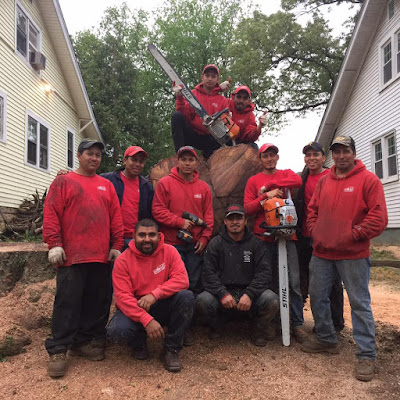Broken limbs: Think of branches like bones in a skeleton. The larger the branch or bone, the longer it takes to heal. If a major portion of larger limbs are damaged or missing, the tree has a lesser chance of recovering to its healthier self. That’s not to say it won’t survive, but it may never be the same.
Trunk damage: Aside from being unattractive, if portions of the upper trunk are damaged, the less likely the rest of the tree above (the ‘crown’) will be properly supported or nourished. In the end, it’s judgment call to determine the long-term viability.
Crown condition: If the tree has sustained damage causing more than a 50% loss of its crown, again, chances are less likely it can continue to grow.
Wounds: Gouges or holes that occur in a tree’s bark can also impact the overall health of a tree. Holes invite bugs and other pests and in time, can weaken the tree. Small wounds, generally 2-3 inches in diameter on tree that is 12 inches in diameter will seal with new bark within a few years. Keep an eye on those wounds to ensure they close up.
Location: You may not have had any choice in the location of your trees (most don’t). However, if you have trees located near power lines, know that they may suffer aggressive trimming at the hands of the power company – just as an example. Other locations that are risky for trees include next to buildings, driveways or your neighbor’s property or power lines, you may find yourself removing them sooner before they cause potential damage or injury.
Trunk damage: Aside from being unattractive, if portions of the upper trunk are damaged, the less likely the rest of the tree above (the ‘crown’) will be properly supported or nourished. In the end, it’s judgment call to determine the long-term viability.
Crown condition: If the tree has sustained damage causing more than a 50% loss of its crown, again, chances are less likely it can continue to grow.
Wounds: Gouges or holes that occur in a tree’s bark can also impact the overall health of a tree. Holes invite bugs and other pests and in time, can weaken the tree. Small wounds, generally 2-3 inches in diameter on tree that is 12 inches in diameter will seal with new bark within a few years. Keep an eye on those wounds to ensure they close up.
Location: You may not have had any choice in the location of your trees (most don’t). However, if you have trees located near power lines, know that they may suffer aggressive trimming at the hands of the power company – just as an example. Other locations that are risky for trees include next to buildings, driveways or your neighbor’s property or power lines, you may find yourself removing them sooner before they cause potential damage or injury.
Keep in mind
It’s important to remember that trees are resilient – they’re not frail or delicate (assuming they are healthy). By design – thick roots, sturdy bark, healthy soil, strong branches – trees are able to “weather the storm” which includes high winds, heavy snow and everything in between. If you’re unsure, it’s always smart to call a professional, but hopefully these tips help you in assessing the damage and overall health of your trees.
